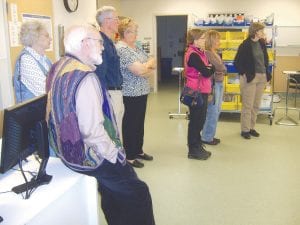North Shore Hospital Head Nurse Bridget Sobieck gave the hospital board a tour of the emergency room on March 24, 2011. The ER dealt with 2,388 cases in 2010, resulting in 111 transfers to facilities outside the county via ambulance and 35 transfers via helicopter or fixed-wing aircraft. Forty others were transported via private car or law enforcement vehicle. Forty percent of the ER’s patients last year were from outside Cook County.

The Cook County North Shore Hospital emergency room can be a very busy place. Last year, it dealt with 2,388 cases, an average of almost 6½ patients a day. Some days, as many as 25 people walked through the ER doors. Other days were slow, with no patients at all.
Being designated as a trauma center, even if it is at the lowest level with no surgical capability, is important because it brings in reimbursement dollars from the state if they do trauma activations, Head Nurse Bridget Sobieck told the hospital board on March 24. Trauma activation happens when the hospital is notified that a trauma case is coming in and they assemble a team that is ready and waiting when the patient arrives.
In 2010, the ER had 10 trauma activations with 14 patients.
Although most patients are already past the “Golden Hour” – the first 60 minutes of a health emergency – when they get to the ER, quick action on the part of the health professionals is vital. Fortunately, an EMS (emergency medical services) team can call for a trauma activation team from the site of a trauma, including requesting that a helicopter be ready to transport the patient.
The emergency room department is working on getting faster, Sobieck said. Activating a trauma team early into a response can cut down on the time it will take to get a patient transported out of the county.
Dr. Sandy Stover said she has enjoyed seeing the two new staff paramedics in action. Paramedic service was begun in March. “It’s going as planned,” Hospital Administrator Kimber Wraalstad said. “I think they’re excited to be here, too. I think they’re liking it.”
The hospital made 386 ambulance runs in 2010. Nurses or doctors went along on 22 of the 186 transfers that were made from North Shore Hospital to other facilities. Of those transfers, 111 were done by ambulance, 35 were done by helicopter or fixed-wing aircraft, 24 were done by private car, and 16 were done by law enforcement.
Forty percent of the ER visits last year were by people who live outside of Cook County. A lot of people had accidents on the ski hill this winter, Sobieck said.
The first two months of 2010 brought 277 patients to the ER, whereas the first two months of 2011 brought 356.
The No. 1 reason for ER visits last year? Open wounds on fingers. Seventy-three of them. “Fish hooks are good to us, too, huh?” quipped Administrator Wraalstad.
ER nurses are required to have certification in basic life support, comprehensive advanced life support, advanced cardiac life support, pediatric life support, and trauma nursing, and all 22 nurses on staff at North Shore Hospital have it, Sobieck said. Doctors must have certification in either advanced trauma life support or comprehensive advanced life support. The hospital contracts with the Wapiti Group for doctors to cover the ER. Sobieck said that the same four to six physicians provide coverage most of the time.
Sobieck recognized the drawbacks of having three patient areas separated only by curtains, although a separate room with a door is used for cases involving things like eyes and obstetrics. Sobieck said having separate rooms for all ER patients would be a nice goal to work toward.
One patient from out of town saw a lot of locals coming and going while she was in the ER, Sobieck said. “Wow, this is a really friendly community!” Sobieck quoted. “Everybody who comes in here says, ‘Well, hi!’ — and I’m thinking HIPPA, HIPPA, HIPPA!” (HIPPA is a federal act requiring that patient health information be kept private.)
Sobieck gave the hospital board a tour of the ER, saying that supplies are well-stocked and organized. She said they offer comforting amenities such as warm fluids and even blankets warmed up in a blanket warmer. The warm blankets have also helped older hospital patients get to sleep at night, she said.
Sobieck pointed out the cabinet holding the many fish hooks that have been removed from anglers in the ER, calling it “the infamous fish hook box.”
Dr. Sandy Stover said, “We have a bit of a competition over who gets to be the first to take out a fish hook each year.”
Administrator Wraalstad said that at a meeting in Chicago, she told someone where she works, and he exclaimed, “One of my fish hooks is on the wall there!”
The North Shore Hospital emergency room worked with the following severe injuries in 2010:
| Motor | vehicle accidents | 32 | |
| Falls | 12 | ||
| Ski/ | snowboard | 9 | |
| accidents | |||
| ATV | accidents | 6 | |
| Snowmobile | accidents | 1 | |
| Other | traumas | 10 |
Top 11 reasons for
ER visits in 2010:
. Open finger wound
. Abdominal pain
. Urinary tract infection
. Otitis media (ear infection)
. Migraine
. Ankle sprain
. Acute pharyngitis (sore throat)
. Open knee/leg/ankle wound
. Acute upper
respiratory infection
. Chest pain
. Syncope and collapse (fainting)


Loading Comments